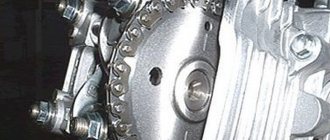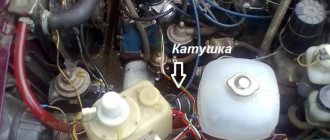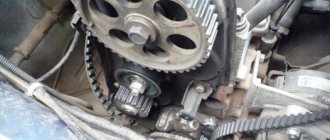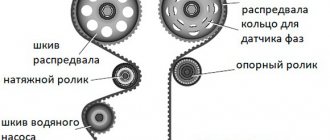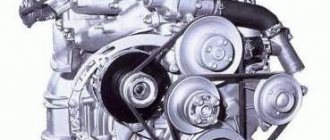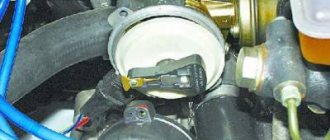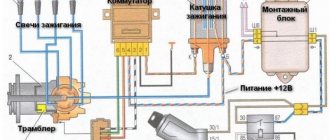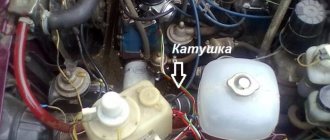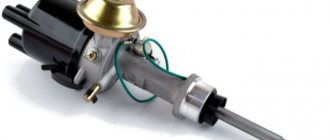Automobile: VAZ-2112. Asks: Kostikov Vladimir Igorevich. Essence of the question: I can’t fix the timing marks, how can I set the timing marks?
I have a problem. When replacing the timing belt, the upper pulleys were not fixed, and now it is not clear how to align them. The marks on the pulleys do not “look” in exactly the same direction. Maybe it would be easier to tighten all the pulleys to the TDC position in cylinder 1? If we are talking about 16 valves, I am familiar with setting the marks on the VAZ-2112: I performed this operation on the timing belt 21124. Well, I have a 1.5 engine. Are there any differences?
Setting timing marks on a 16-valve VAZ-2112 with your own hands
Car: VAZ-2112.
Asks: Kostikov Vladimir Igorevich. The essence of the question: I can’t correct the timestamps, how to set TMV tags? I have a problem. When replacing the timing belt, the upper pulleys were not blocked and now it is not clear how to expose them. The marks on the pulleys do not "point" in exactly one direction. Maybe it would be easier to turn all the pulleys to TDC in cylinder 1? If we are talking about 16 valves, then the markings on the VAZ-2112 are familiar to me: I performed this operation on timing belt 21124. Well, I have a 1.5 engine. Are there any differences?
In what cases is replacement required?
To understand that the timing belt needs to be replaced, you need to visually inspect the element.
It is necessary to stop using it if the following damage is detected:
- cracks, cuts have appeared on top of the timing belt, or its base is delaminating;
- if the notches located on the inside of the belt are damaged.
The most common reasons why a belt breaks:
- the car enthusiast simply does not know how to tighten it properly;
- improper operation or use of the belt for longer than the specified period;
- contact with the belt surface of coolant, fuel, lubricant;
- incorrect operation of the water pump;
- play in the belt rollers: tension and support.
If you do not ensure the correct adjustment of the belt, do not inspect and replace the rollers on the VAZ 2112, this can lead to other breakdowns. We will find out which timing belt rollers for the VAZ 2110-2112 16v are better from the author of the video, MegaMeyhem.
If the timing belt breaks, it will disrupt the operation of the entire engine. Then everything descends into chaos: valves and pistons touch each other because their movements are not controlled. As a result of the impact, the valves bend and, touching the pistons, damage their outer walls, scratch the cylinders and important parts of the gas distribution mechanism.
In addition to visual diagnostics of delamination, cracks and other things, it is recommended for a VAZ 2112 car (including the injector) every 50 thousand km. movement to change the belt. Which timing belt for a VAZ is better to choose is described below.
About timing marks and their displacement — Lada 2111, 1.6 l., 2005 on DRIVE2
I have been looking for information about the valve timing of 124 internal combustion engines for a long time, and now I came across this material completely by accident. In general, I understand what is being said here. But it would be nice if someone thoroughly chewed on what exactly a change in one or another direction of pulsations, the angle of inclination of the first peak, passing through zero and the maximum value of the vacuum vacuum mean.
From my own experience, I can say that shifting the entrance 1 tooth to the right adds elasticity. And also the intake and exhaust are shifted to the right. And shifting the descent to the left gives a noticeable jerk (acceleration) somewhere around 3500 rpm.
Timing PHASES on a VAZ 2112. The belt is specially moved to one tooth, forward and backward. Engine 21124 (1.6 16kl.) Gearboxes:
Gear 2112
.
Norm
• ХХ = 840 rpm (engine is warm, measured after turning off the fan, t = 97 degrees) • the difference between DR and DPKV is 0.32 degrees; First, auto-tuning is performed according to DPKV, then an indicator (1 or 2) is set at the beginning of the line (i.e., the value of the marker displayed on the line will be equal to 0). Auto-tuning is then performed based on DR and the marker value (on the ruler) previously set at the beginning of the ruler. The displayed value will be considered the difference. 2) the difference between DPKV and DR is calculated as in point 1, but vice versa. First, auto-tuning is performed using DR, then using DPKV 3) Real UOZ - UOZ according to the scanner 4) As a result of all experiments, the ECU did not generate a direction finding error (phase sensor
Release the norm of tooth 0; 1 posterior tooth entry
Release the norm of tooth 0; 1 posterior tooth entry
Signs: • ХХ = 840 rpm (t = 92 degrees) • The angle of inclination of the 1st peak has increased, it has become softer • Pulsations have decreased • The maximum values of vacuum and vacuum have decreased • Extra transitions from 0 to appeared) Automatic adjustment by DR • the difference between the DR and DPKV is -8.44 degrees • SOP 25 degrees (real 15 degrees) • the closing degrees of the exhaust valves have shifted slightly to the right • the phase overlap has shifted slightly to the right side b) Auto-tuning for DPKV • the difference between DPKV and DR is +8, 27 degrees • SOP 16 degrees (actual 15 degrees) • Exhaust valves close late and intake valves open later • Overlap phase shifted to the right
Release the norm of tooth 0; Input 1 tooth forward
Release the norm of tooth 0; Input 1 tooth forward
• ХХ = 850 rpm (t = 92 degrees) • The angle of inclination of the 1st peak has decreased, it has become steeper • The pulsations have become larger • The maximum values of vacuum and vacuum have become much larger • There are extra transitions through 0 a) Auto-tuning in accordance with DR • difference between DR and DPKV is +15 degrees • UOZ 3 degrees (15 real degrees), missing in DR waveform b) Auto-tuning according to DPKV • difference between DPKV and DP – 15 degrees • UOZ 16 degrees (15 real degrees) , missed within the DR waveform • Exhaust valves close earlier and intake valves open earlier • Overlap phase shifted to the left Release 1 tooth forward; Normal input 0 tooth • XX = 840 rpm (t = 92 degrees) • The inclination angle of the 1st vertex has remained virtually unchanged • Pulsations have decreased • The maximum values of vacuum and vacuum have decreased slightly DPKV to + 3 degrees • SOP according to DR 12 degrees ( real 15 degrees) b) Auto-tuning by DPKV • difference between DPKV and DR is -3.47 degrees • UOZ by DPKV 15 degrees (real 15 degrees) • Drain valves close a little earlier and inlet valves open a little earlier • The overlap phase is shifted to the left
Release 1 tooth forward; Standard input 0 teeth
Release 1 tooth forward; Standard input 0 teeth
Will a spark ignite a flame? Not always! — “Electrics” on DRIVE2
This modification will be useful in almost the entire line of VAZ injection engines, regardless of the type and composition of the ECM equipment and the ignition system in particular.
Just a word of caution - based on the results of comments and questions. ! ! ! Intervening and making changes to the electrical circuit of a car requires at least basic skills in electrical engineering and awareness of the actions being performed! ! ! If you feel that electrical circuits and car electrics are a little out of your profile, contact a more qualified person or an experienced auto electrician. This is in your own interests. And it will save you from unpredictable consequences.
Updates and additions are at the end of the article.
A detailed detailed analysis of changes in the ignition system after modification is described here: Part two.
Expanded results In order. Engine VAZ 21124. 1.6 liters, 16 valves. Individual ignition coils (or dual module with high-voltage wires). Everything is beautiful. And at first glance, it seems that everything is thought out, so it should work clearly and reliably. It turns out that this is far from true. This is a VAZ!
Customized ignition coils
Quite a lot has been written about ignition problems on this engine - about the choice of spark plugs, replacement and selection of individual ignition coils (hereinafter - IKZ).
So I came face to face with this problem.
The main manifestations are that the engine rotates unevenly at idle (speeds dance in the range of approximately 720-840 rpm), sluggish acceleration with twitching, increased consumption. In principle, most people understand that misfires are rare, but they do happen. The ECU doesn't see them directly. Last year, one coil clearly started to fail - the ECU saw it. I replaced it and it started to loosen up a bit. But still the engine was missing something. What a good spark! Here's more about this. From the versions: - replacing the spark plugs (the current NGK ones lasted only 7 tons km) with something more expensive from the “platinum, iridium” series, etc. - an expensive option. — changing the IKZ, and they are a little over 7 years old (the original ones are BOSHevsky, the mileage is 75 tkm) - it’s a little expensive (the cost of one IKZ is around 540 UAH ($22), and there are four of them) and there is no confidence that the problem will go away. — Mass air flow sensor, which is also not fun... — look into the ECU to check the serviceability of the keys, current-limiting resistors, etc. Acting at random or based on assumptions is not my method or my approach.
Reading the ECU showed: 1. Speed jumps 2. Injection time jumps, slightly 3. Reduction ratio jumps at idle (9-15 degrees) - a bit too much 4. Power supply, mass air flow sensor, TPS - everything is stable and beautiful.
5. ECU masses - everything is ideal (previous modifications and correct wiring were made) Verdict - unstable sparking.
The ICP parameters were measured - resistance of the primary winding, inductance, resistance of the secondary winding (taking into account the diode in the high-voltage circuit), checking for the absence of short circuits.
www.drive2.ru
Set the timing marks correctly - otherwise you will bend the valves!
The VAZ-21124 engine has a peculiarity: no matter how its pulleys rotate, it does not bend the valves. With the 21120 engine (16v 1.5l) such bits will not work! If the pulley positions do not drop too far, try putting on the belt and moving the mechanism to the "TDC 1 and 4" position. And from now on, always use the instructions:
- The crankshaft is brought to the required position by checking the mark on the generator transmission pulley (photo 1) or on the crankshaft pulley (photo 2);
Alternator drive pulley and crankshaft pulley
Exhaust and inlet pulley
Theoretically, the marking on the VAZ-2112 is the same, regardless of what type of engine we are talking about. Here is a photo of engine 21120.
What it all looks like in reality and in the instructions
Take the time to locate the inspection window on the gear housing. There is another sign under the thorn.
The last step is optional. And they do this so as not to redo all the work from scratch.”
- The mark on the crankshaft pulley sometimes breaks: use control method “1” (photo 1) or “3” (photo below).
- The number of belt teeth between o is 16;
Updates for VAZ-21124
On the 1.6 engine, all actions are performed as described above. There is one exception: the generator drive pulley is installed according to the mark on the casing (see photo).
Generator drive pulley, engine 21124
However, if this sign is not present, then use the proven method - count 20 teeth from the body of the DPKV. Instead of 21 there should be "pass".
The timing pulleys can be turned at will - the pistons never touch the valves. Compare the appearance of the pistons of two different engines - it will become clear what we are talking about.
Two different 16-valve valves
For those who don't understand anything
The number of teeth on the crankshaft pulley is 21, on the camshaft pulleys – 42. When the crankshaft is rotated 360 degrees, the camshafts rotate 180 degrees. Typically, a complete engine cycle consists of two revolutions of the crankshaft (720 degrees).
In theory, an alternative tuning method could be used. Place the marks on the camshaft pulley down. Then the mark on the crankshaft pulley should point upward (TDC 1 and 4).
If there is no clasp, you can make one yourself. A suspension spring remover will also work (see photo).
Price issue
In the case of replacing one timing belt yourself, the cost of repair is determined only by the price of the belt. This is from 630–650 rubles. Rollers cost about the same, so a repair kit consisting of a belt and two rollers can be purchased for about 2 thousand.
rubles If you decide to also replace the pump, then another 1200–1300 rubles are added to this figure.
Compared to work at a car service center, replacing one belt yourself will save about 1,500 rubles, and replacing a belt and rollers will save about 3 thousand rubles.
Replacing the timing belt 16 cl engine — Lada 2112, 1.6 l., 2007 on DRIVE2
Replacing the timing belt VAZ 2112 1.6 16 cl.
1. Remove the timing belt cover. Timing belt guard secured with six bolts. Remove the chip from the crankshaft sensor, unscrew the bolt and remove the sensor.
2. There is a missing tooth on the pulley, this is not without reason, this allows the crankshaft sensor to determine the top dead center, and also allows you to block the crankshaft, unscrew and tighten the pulley bolt.
3. The pulley is then aligned with the crankshaft sensor hole and a suitable tube or other suitable object is inserted through the sensor hole, in my case it is a hex wrench, the pulley is locked and then unscrewed and removed.
4. Loosen the tensioner pulley nut and remove the old timing belt.
5. Install a new belt, the belt can be installed by moving the right camshaft with a wrench, or you can remove the tensioner roller in any way you like.
6. Tighten the pulley bolt back and align the timing belt drive gear to the marks. If there are no marks on the oil pump body, put marks on the flywheel and for one make a mark on the oil pump with a chisel, this will be more convenient.
7. We join the marks of the camshaft pulleys so that the timing belt drive gear does not get lost
8. Use a special wrench to tighten the belt with the tension roller. If there is no key, don't worry, you can tighten it with two nails and a screwdriver between them, or you can take a steel fork, remove the two center prongs completely, shorten the outer two in half and fold them over. Don't forget to tighten the tensioner nut. (To tighten the belt, turn the tensioner pulley counterclockwise (about 10-15 °), to loosen it clockwise)
9. We check the crankshaft two full turns and check the marks, if all three marks match, put the pulley in place, do not forget the generator belt and crankshaft sensor, then the belt cover and you can start the engine.
Timing belt tension
1. Check the belt tension. A correctly tensioned belt should rotate 90 ° from the finger force (1.5-2 kgf) in the middle between the crankshaft and camshaft pulleys.
2. I run two fingers between the camshafts and up and down. 5-6 mm swings back and forth, then I go away.
3. Adjust the timing belt tension using a suitable tool. The most correct belt tension is 2 kgf. Having achieved this, fasten the fixing nut.
4. The manual inspection method is described in detail in the "Manual". It involves checking the tension of the timing belt at the center of the branch between the camshaft pulleys. It should be such that the belt deflection is 5.4 mm under the influence of an object 3 mm wide with a force of 10 kg. Deviations in any direction are allowed no more than 0.2 mm. The engine must be at “ambient air” temperature (+ 15-30 ° C). A belt that is too tight will break - the strength of the strings is limited. And the tighter the belt is, the faster the threads will break. Even a weakened belt will not run for long, because when entering the pulley, the belt teeth do not fall into the grooves of the pulley teeth - undercutting occurs and the subsequent separation of the teeth from the base.
Belt faults
Malfunctions of the timing belt can arise as a result of its long-term operation, and can also be the result of incorrect adjustment or malfunctions of the pump or tension roller. These include:
- violation of the integrity of the belt (cracks, delamination);
- deformation;
- belt break.
If any of the specified malfunctions are detected, the belt must be replaced.
Causes of belt breakage
One of the common problems with the model is the failure of the timing belt. The reasons for this may be different:
- Simple wear and tear caused by a long period of use of the vehicle;
- Regular increased loads under which the engine has to work intensively;
- Mechanical damage as a result of improper operation or received during the repair of other components;
- Manufacturing defect.
Over time, it stretches so much that the gear teeth jump by 1-2 links. This disrupts the valve timing and causes interruptions in engine operation. But this is the best-case scenario for such a situation. The worst is when the strap breaks and the valves bend. By the way, this problem was finally solved on the new Lada Vesta.
List of damage to the timing belt on the VAZ 2110
Replacing the timing belt of a VAZ 2110 8-valve injector with your own hands is carried out:
- As a result of increased tension, the surface begins to become shaggy. Gaps appear.
- If the product was loosely tensioned, this leads to cutting off the tooth. In such a situation, replacing the VAZ 2110 8-valve timing belt on a VAZ 2110 is required immediately.
- The teeth are largely worn. This is also a consequence of poor tension adjustment.
- The surface of the product is covered with small cracks. This happens due to prolonged overheating or hypothermia.
- Sometimes the wear area is between the teeth. This is also the result of poor belt tension.
- If oil constantly leaks from the engine and gets on the belt, then the product is removed. Then you need to find and fix the leak. The timing belt is replaced with a new one.
- On a VAZ 2110 with 8 valves, the timing belt is changed if there was a misalignment during its installation. Its end wear is observed.
When driving the car, you must constantly listen to noises. When it is clearly audible in the engine area, it means you need to stop and tighten the belt.
In some cases, the tooth skips. This problem is indicated by a signal from the sensor. It is necessary to stop and carry out another drive adjustment.
Timing belt life
From time to time you need to inspect the belt and replace it if:
- the belt structure began to delaminate;
- cracks appeared on the surface;
- the teeth that are on the inner surface of the consumable are damaged.
But what could be the reasons that the consumable has reached a state where it is no longer possible to do without replacing it:
- the consumable was not properly tensioned initially;
- the belt has been used longer than expected;
- a lubricant has reached the surface;
- the water pump did not work well;
- the tension roller had play.
If you do not periodically inspect the belt and do not change it on time, this can ultimately lead to a break. And a break is very serious, since in this case the pistons will collide with the valves. As a result, they will be damaged and the engine part will have to be seriously repaired. A broken belt drive will cause real chaos, as a result of which other timing parts will also suffer serious damage.
The manufacturer promises that you should be interested in the condition of the belt only after 50,000 km. This is not entirely true, because premature wear of consumables can be influenced by a number of factors, such as aggressive driving or weather conditions. Therefore, it is recommended to inspect the belt drive after 20-25,000 km.
Signs by which you can determine the need to replace the VAZ 2110 timing belt
To replace the timing belt on time, you need to monitor the condition of the engine. The timing belt needs to be replaced if:
- there are oil leaks on it;
- there are many cracks and signs of increased wear on its surface;
- timing belt teeth are damaged;
- the belt has delaminated, cuts, bulges or folds have appeared;
- threads appeared on the surface.
Injector types
The injector controls fuel injection and can also control the ignition. On all new injection machines, the ignition is set by a computer and adjusted by compiling various firmware. But this was not always the case, and on old cars, the same Japanese ones from the 90s, the ECU only regulates fuel injection, and the ignition timing is set using a distributor and set in the same way as on old models. Lada, but depending on the speed, the ignition timing is adjusted using a more complex vacuum system than the Zhiguli carburetor. Sometimes a pipe breaks during operation and the traction is lost; you will have to look for and correct this defect.
Ignition system sensors and marks
For the ignition system to work properly, the computer must read the correct information from the sensors. In the future, this information will be processed using fuel maps embedded in the injector.
The main signal comes from the crankshaft sensor. This sensor shows the position of the crankshaft at a given moment and, guided by it, calculates at what moment it is necessary to inject fuel and at what moment the same fuel should be ignited, depending on the engine speed, which is also determined by this sensor.
1 – drive shaft of the drive disk; 2 – crankshaft position sensor; 3 – angle of rotation of the crankshaft; 4 – output signal of the crankshaft position sensor
And here is what a typical signal looks like when the computer receives it from the crankshaft sensor. Notice the 270°: this is like the zero point, which tells the computer that the motor has turned and that a new cycle is starting. This is achieved by missing a tooth on the crankshaft sprocket.
Selection options
In the automotive market you can find several companies that produce high-quality belts. Its length should be 742 mm.
When choosing a belt for 16-valve engines, you can pay attention to:
- Factory belt from the Volzhsky Automobile Plant: Lada 21126-1006040. This is a durable belt made from quality material. It is not so expensive that you can spare money.
- Lynx 137FL22 – timing belt from a Japanese manufacturer. On its inner side there are 137 serrated cuts. Since it is relatively inexpensive, it will have to be replaced more often than others. This does not mean that the quality of the material is bad. Japanese products have proven themselves well among car enthusiasts.
- Belts from Bosch. This company has established itself in the market as the embodiment of quality and sustainability. The belts from the manufacturer turned out to be excellent and, as a result, they are deservedly popular among car enthusiasts. The recommended service life of the straps is fully met.
- German ContiTech belt. Manufacturers tried to make the product durable by including polyamide fabric, fiberglass and synthetic rubber.
- Optibelt. Belts from this company are also installed on 12-valve engines. They enjoy a good reputation among car enthusiasts due to their large resource. This is because cases of belt “death” are almost never recorded, and it serves its life due to the quality of the materials used.
- Gates 5631XS heads the line of the most popular belts, the quality of which is at its best. This is a well-deserved sales leader. Gates belts are made of high-quality material, and therefore the risk of timing belt breakage on a VAZ with a 16-valve engine is reduced to zero.
- BRT belts of domestic production. Experts believe that BRT is the Russian analogue of Gates. What is noteworthy is that the quality of a domestic belt is not inferior to a foreign product, but its price is an order of magnitude lower.
After how long to change the timing belt, we find out from the video from the AVTOTEMA TV channel.
Replacement process
When does a belt need to be replaced? If you naively trust the manufacturer and hope that it will last all 100 thousand kilometers, then problems cannot be avoided. An experienced and knowledgeable driver will always conduct a visual inspection, noting signs of replacement, such as:
- the appearance of hanging threads and loosening of the belt.
- various folds, cuts, ligaments, etc.;
- traces of oil on the belt;
- excessive wear of teeth located on the inside of the belt surface or cracks;
Note. It would be a good idea to check the tensioner pulley, which, if it malfunctions, can cause colossal damage not only to the belt, but also to the main parts of the internal combustion engine.
Replacement is carried out using the following tools:
- long lever or screwdriver.
- special circlip remover;
- keys 15 and 17 (normal and ringtone);
- a special key with which you can adjust the take-up reel;
Belt removal
Let's proceed with the replacement, presented here in the form of detailed instructions:
- place the piston of the first cylinder at the top dead center position;
- remove the generator drive belt;
- de-energize the battery;
- subsequently turn the tensioner roller slightly to reduce the timing belt tension;
- take a 15 mm wrench and unscrew the bolt securing the tensioner pulley;
Note. To easily unscrew the generator drive mounting bolt, you need to rest the support against the crankshaft so that it does not rotate. It is best to use the services of an assistant who will prevent the crankshaft from turning when the bolt is loosened.
- remove, but very carefully, the washer from the drive pulley;
- remove the generator drive pulley;
- then take a 17mm wrench and unscrew the bolt securing the crankshaft pulley;
- remove together with the washer;
- remove the timing belt from the crankshaft pulley.
Installation
Before you begin installing a new timing belt, you should carefully prepare everything. First of all, this concerns cleaning the pulley from oil and dirt, as well as cleaning the take-up reel.
Note. If the parts are very dirty, it is recommended to use a cloth soaked in gasoline or white alcohol.
Like:
- we mount the generator drive pulley in place (there is a special recess on it that needs to be placed);
- put the new belt in place.
Note. When installing a new belt, pay attention to the tension of the drive branch.
- take a 15 mm wrench and tighten the bolt that secures the tensioner pulley.
- turn the roller until the notch on the disk coincides with the protrusion on the inner sleeve of the tension roller (rectangular protrusion);
- We arm ourselves with a special key and extractor;
- insert the key into the grooves of the tensioner roller located outside;
Note. If after installing the belt you hear a characteristic noise in the camshaft, there are probably problems with the tension roller bearing, which is also of great importance for internal combustion engine mechanisms.
To check this, you need to disassemble the rollers and begin to slowly rotate the bearing, making sure that there are no gaps or jams. In addition, you need to pay attention to traces of oil leaks. If the above malfunctions are detected, it is necessary to replace the roller itself.
We change this part too
To replace the tension roller you will have to buy a new one, which is not that expensive. It is also recommended to watch this video.
Note. When installing a new tension pulley, make sure the holes for the special wrench are facing outward.
Ignition control
Electronic ignition control
How to set the ignition angle? In systems with electronic ignition control, this can be done using computer diagnostics that are connected to the electronic control unit (ECU) or "brains" of the car. And there you can see how the engine operates in real time: what signals the sensors receive, what engine speed, fuel consumption, injection time, ignition time and other input and output data.
Essentially, you don't need to change anything while running unless you change the firmware. That is, if the machine somehow began to work incorrectly, then most likely there could be several reasons:
- An incorrect signal is received from the sensors: in this case, you can replace the supposedly faulty sensor with a replacement one that is known to be good, and see if the result changes.
- The mains voltage is incorrect and as a result the sensors produce an incorrect signal. The input signal to the sensor is 5 V, if this value is different, the ECU will receive incorrect input data and the engine will not be able to operate normally.
- Faulty ECU. Quite often it happens that, having considered everything possible, it turns out that the brain has flown. But it’s not scary, they are cheap at VAZ.
Therefore, the ignition itself is not installed on injection machines; it is already included in the system, but it is worth checking whether the signs are set correctly.
Adjusting the ignition marks on the VAZ-2110 injector
When the engine is running, some phases must work synchronously, the camshaft must coincide with the crankshaft, and the timing of fuel injection and ignition must be associated with them. Let's look at all this using the VAZ-2110 as an example.
How to set the ignition on a VAZ 2110 injector
If the car does not start, shoots, sneezes and everything is in the tube, then there are no signs somewhere and this needs to be solved.
On any car, the timing marks must be set perfectly, only then it will work normally. On the VAZ-2110, the crankshaft mark is located on the flywheel. You need to look through the inspection window on the gearbox housing, through which you can see the flywheel. It's better to use a flashlight because it's not that easy to see.
How to set the ignition on a VAZ 2110
Among the most popular domestic cars, it is worth highlighting the VAZ 2110, or as it is also called “Ten”. This car was produced from 1995 to 2007. The 8-valve VAZ 2110 was a kind of replacement for the usual carburetor. The main difference between the models is the method of supplying fuel to the fuel cylinders. In the injection machine, everything happened under pressure.
The VAZ 2110 has 8 valves and the engine is more powerful. In this case, fuel consumption is lower. Repairing a car requires the use of additional equipment and painstaking work. Engine capacity 1.5 – 1.6 liters. How to correctly set the ignition on the valve injector of a VAZ 2110 8? To do this, you need to know the technology of work, and then all the actions will seem simple. This will be discussed further.
When to tension the timing belt
The timing belt tension on the VAZ-2112 and other VAZ models is carried out in the following cases:
- Installing a new belt;
- Loose belt;
- “Slipping” of the belt with a violation of time;
- Replacement of the tension roller and other timing drive mechanisms.
If the reason for the operation is a break or “slippage” of the belt, you must first make sure that the valves are in good condition. Failure of the gas distribution mechanism (drive) leads to engine failure on 16-valve 1.5-liter power units. However, if the drive fails at high speeds, the valves and CPGs also fail on other engines.
Check the functionality of the timing belt on the VAZ-2114 and other models equipped with 8-valve units by turning the camshaft manually. The operating mechanism should turn with some effort. This usually does not affect the faulty one.
During the procedure, it is necessary to check the compression in each of the cylinders. The easiest way to do this is to cover the candle hole well with paper. If there is pressure in the cylinder, the pin will be pushed out of the seat at some point during the firing of the camshaft. It is not recommended to carry out such a test on 16-valve engines. The risk of damage to initially good fittings is too great. There are no holes in the pistons of one and a half liter engines of this type. Consequently, the downward moving valves bend as they contact the piston surface.
What can cause a timing belt to break?
In a VAZ-2112 car with 16 valves, rupture of a belt part can occur due to:
- Strong or, on the contrary, weak tension. To make sure it is tensioned correctly, it is recommended to use a special device called a frequency meter. Measurements should only be taken from a cold engine, the indicator should not exceed 155 Hz +/- 3 Hz.
- A rupture will be inevitable if the part has been in use for a long time and the replacement was not made in a timely manner. Since there is a constant temperature difference during the working position, the belt element gradually collapses, cracks appear on it, which leads to rupture.
- Due to improper placement of the bearing, which can jam and tear the timing belt.
- Due to leakage of the oil seal, which coats the part with oil.
- Due to a low-quality timing belt, which was installed in the 16-valve VAZ-2112 engine by the manufacturer.
These are the most basic reasons that lead to the rupture of the HMS belt. If you carefully monitor the technical condition of the machine and repair it yourself at the slightest sign of breakdown, you can avoid very unpleasant situations that can happen at any time.
Work order
Before starting work, you need to enter information into the control unit. Sensors will help with this.
To set up the ignition on the 8-valve injector of a VAZ 2110, you need to have some skills related to car repairs:
- Find the gas distribution mechanism and remove it from the case.
- The distance between the sensor and the crankshaft toothed disk should be no more than 0.5 - 0.7 mm. This is necessary so that the pulse from the sensor can pass without continuous sparking.
- The crankshaft pulley should remain in place. How can I check this? The marks located on the flywheel will help with this. They should match the marks on the gearbox. To do this, you need to turn the crankshaft.
- Make sure the mark on the oil pump aligns with the cylinder block protrusion.
- The mark on the camshaft drive wheel should align with the rib on the timing belt cover.
- Pistons 1, 4 cylinders, while all points are aligned, will be in the upper position. The distance between the teeth should correspond to the protrusion on the cylinder block. The tooth located in the 20th position will coincide with the crankshaft sensor.
- The signal will be sent from the sensor to the internal combustion engine control system. This will mean that the piston of the first cylinder is in the upper position in a compressed state.
Description of disassembling the mechanism
Disassembling the timing drive assembly on a VAZ 2110 with 8V and 16V engines is somewhat different; in the case of a 16-valve engine, some additional elements must be removed. Therefore, a description of the process will be posted specifically for it with reservations for the 8-valve unit. At the very beginning, you need to remove the protective plastic casing and, for greater ease of operation, remove the air filter housing and move it to the side . A sensor is installed below, opposite the crankshaft pulley. You need to disconnect the connector from it, unscrew and remove the sensor itself (this is not necessary in an 8-valve engine). Next, in both types of engines, you need to rotate the crankshaft to align all the marks on the camshaft pulleys and the engine housing. This alignment is checked by matching the mark and the slot on the flywheel; to do this, remove the rubber plug from the socket on the gearbox.
Carefully rotating the crankshaft, align all existing marks on the pulleys
Next, in order to disassemble the mechanism and remove the timing belt, you will first need to loosen and remove the alternator belt from the pulley. When performing this simple operation, the latter should be carefully examined. It is quite possible that it is also in poor condition, and at the same time the VAZ 2110 alternator belt will also need to be replaced. In cars equipped with power steering, this is an additional operation, which will be discussed below.
The next step is to loosen and unscrew the pulley bolt on which the VAZ generator belt of the tenth family is put on. To do this, jam the crankshaft with a screwdriver or a small pry bar and loosen the bolt with a spanner, after which you can remove the pulley itself. Now you can unscrew the roller, the timing belt tension will decrease, which will make it possible to unscrew and remove the support roller.
It is important not to lose the special washers that are located under the rollers (there is only one roller in the 8V engine). Disassembly is complete, the old timing belt can be removed.
Setting the piston of the first cylinder to the TDC position of the compression stroke
Setting the piston of the first cylinder to the TDC position
When carrying out work related to removing the camshaft drive belt (timing), the valve timing can be interrupted, to prevent this from happening, the piston of the 1st cylinder is set to the TDC (top dead center) position during the compression stroke. If the valve timing is incorrect, the engine will not run smoothly and will not perform properly. Set TDC according to the mark on the camshaft pulley (when installing according to the marks on the flywheel or crankshaft pulley, the piston of the 1st or 4th cylinder may be in this position). Then make sure the marks on the flywheel or crankshaft sprocket are aligned (if the alternator drive pulley was removed). If the marks on the flywheel or crankshaft pulley do not match, the valve timing is incorrect (the piston of the 1st cylinder is not installed at TDC). In this case, you need to remove the camshaft drive belt and rotate the crankshaft until the marks match. Important! Rotate the crankshaft only by the pulley bolt (do not rotate the crankshaft through the camshaft pulley itself).
TIP Since it is inconvenient to turn the crankshaft using the pulley bolt, there are two ways to do this
- Engage any gear and suspend the front wheel. Then rotate the suspended wheel until the mark on the camshaft pulley aligns with the mark on the rear camshaft drive belt cover.
- Engage any gear (preferably IV) and slowly move the car until the mark on the camshaft pulley aligns with the mark on the rear camshaft drive belt cover.
TDC marks VAZ 2110 2114 8 valves
The TDC marks are located on the camshaft sprocket (lug) and on the camshaft drive belt rear cover (screw).
In addition, the markings are located on the flywheel (risk) and on the scale of the rear cover of the clutch housing (triangle cutout). For clarity, the gearbox has been removed.
In addition, marks are located on the crankshaft sprocket (dot) and on the oil pump cover (V-groove). These marks are only visible when the generator drive pulley is removed.
You will need: 17" wrench, 10" socket wrench. 1. Disconnect the cable from the “-” terminal of the battery.
2. Set the gear shift lever to the neutral position, place stoppers under the car wheels.
3. Remove the right front wheel and the right fender in the engine compartment.
4. Open the hood and remove the three screws that secure the front camshaft belt housing. Note. Screws on the mounting side of the cover also secure the cable clamps. Remove the front cover.
5. Rotate the crankshaft using the bolt securing the generator drive pulley until the marks on the camshaft pulley and the rear cover match.
6. Remove the plug from the hole in the clutch housing and check the alignment of the marks on the flywheel.
TDC marks VAZ 2112 2111 16 valves
About the engine mod. 21126 (16 cl) are located on the camshaft sprockets (lugs A) and on the rear camshaft drive belt cover (slots B).
In addition, the markings are located on the flywheel (risk) and on the scale of the rear cover of the clutch housing (triangle cutout). For clarity, the transmission has been removed.
Also, all engines have marks on the crankshaft sprockets (dot) and on the oil pump cover (V-groove). These marks are only visible after removing the alternator drive pulley.
You will need: 17" wrench, 5" hex wrench, T30 TORX wrench, Phillips screwdriver.
1. Disconnect the cable from the negative terminal of the battery.
2. Using a Phillips screwdriver, remove the screw that secures the right fender to the wheel arch trim
3. Using a torx t30 wrench, remove the two screws that secure it to the case
4. Remove the screen.
5. Open the hood and use a 5-point hex wrench to remove the five bolts that secure the upper front timing belt cover 6 . and remove the cover.
7. Using a 17-inch wrench, rotate the crankshaft by the bolt that secures the alternator drive pulley to it until the marks on the camshaft pulleys and the rear cover line up.
8. Remove the plug from the hole in the clutch housing and check the alignment of the marks on the flywheel (the thermostat has been removed for clarity).
Consequences of untimely shift
If the timing belt is not changed in a timely manner, it may break. While driving on the highway, this can lead to an accident. If the accident was avoided, you will have to spend money on a tow truck to deliver the car to the repair site.
If the belt breaks, the movement of the camshafts and valves will stop, but the movement of the crankshaft will continue, which may result in damage to the valves as a result of the impact of the pistons. Repair may be limited to replacing the timing belt and rollers. But only if an 8 valve engine or 16v 1600 cc is installed.
If the valves are bent, a major overhaul of the engine will be required, which will cost from 20–30 thousand rubles. In some cases, it will be cheaper to purchase a new engine, although this will lead to other problems - registration. Based on the above, it is much easier, safer and cheaper to change an inexpensive part on time.
How to evaluate the work already done
Accurate diagnosis is carried out using a computer. However, you can also independently evaluate the correct operation of the circuit.
- With the ignition off, check the contacts.
- Find the voltage inside the module at terminals C and B.
- Check the high voltage cable. To do this, you need to take a candle and put it in the cap. In this case, it should be secured to the cylinder block. If you start the internal combustion engine with the starter, a spark will appear. The check is carried out for all wires. If the spark does not appear, the entire ignition system must be checked or even replaced.
- If the engine continues to run poorly, the fuel system needs to be checked.
For the VAZ 2110 carburetor model, markings are also made to adjust the ignition system.
If the ignition of the 8-valve injector of the VAZ 2110 occurs earlier or, conversely, late, then the ergonomics of the entire engine deteriorates. Power is also reduced. The engine is exposed to high temperatures and excessive loads. Among other things, detonation may occur. All this can lead to loss of ignition in the VAZ 2110.
Checking the ignition coil with a multimeter
Checking the voltage at the wire terminal block
:
- Disconnect the block with wires from the ignition coil (on the H4M engine, to access the coils of cylinders 1 and 2, remove the intake pipe).
- Turn on the ignition and measure the voltage at terminal 3 of the block (the pin numbering is indicated on the ignition coil).
- The output voltage must be at least 12 V. If it is less or less, the battery is discharged, there is a fault in the power circuit, or the engine control unit (ECU) is faulty.
- Turn off the ignition.
Setting the ignition timing
Required for carburetor models only. To work you will need a tool - a strobe light. It is sold in almost all car dealerships and at a reasonable price. It is also advisable to have a wrench to unscrew the nut that secures the distributor.
When choosing the correct ignition timing, mark 1 on the flywheel should be between the central division (notch) 2 and the previous division 3 of the scale. If not, adjust the ignition timing.
To adjust the ignition timing on a VAZ 2110 you need to:
- Do minimal work. The crankshaft should rotate at a maximum speed of 820-900 rpm. The tube coming from the carburetor and connecting to the vacuum valve must be disconnected.
- Take a strobe light and connect the cables to the “-” and “+” terminals of the battery. The tip of the high-voltage wire must be removed from the socket and the wire coming from the strobe inserted.
- Remove the rubber plug from the slot in the crankcase and point the strobe light at the free space. Next you need to start the car. During its operation, it is necessary to apply a mark to the flywheel. As soon as the engine starts, the strobe light starts. Flashing will indicate a sign. The flashing will be fast and the sign will remain stationary. However, if you move the dispenser, the label will move.
- To move the label and dispenser, you must loosen the top nut securing the dispenser, as well as the 2 lower nuts. Subsequently, the distributor can be turned slightly. At this time, the mark will also move with the strobe light.
To understand the process of adjusting the ignition in more detail and clearly, it is recommended to watch the corresponding videos. To resolve the issue of how to set the ignition on the VAZ 2110 8 injector, you can also consult with experienced car owners.
